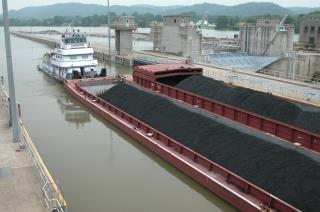It’s time to consider charging shippers a user fee to help maintain then U.S. inland waterways transport system, according to a new report issued Tuesday by the National Research Council.
The U.S. Army Corps of Engineers needs a better plan for ensuring that limited resources are directed toward locks and facilities that are most critical to maintaining system reliability and performance. While barge operators contribute to the Corps’ inland system by paying a fuel tax — and supported a tax increase in the agency’s new budget — it may be time for a more direct user fee on commercial traffic to help pay for the $650 million annual operations and maintenance budget, the report suggested.
“In a climate of constrained federal funds and with O&M becoming a greater part of the inland navigation budget, it is reasonable to examine whether beneficiaries could help pay for the system to increase revenues for the system and improve economic efficiency,” according to the report, a product of an 18-month study by the NRC’s Transportation Research Board.
“This is not a new topic … It goes back to the 1940s,” said Leonard a Shabman, a resident scholar with Resources for the Future, one of the report authors who has researched water and land management issues for the Corps and other groups.
“There has been a persistent pattern of opposition to raising costs to the users,” Shabman said at a Washington, D.C., event Tuesday announcing the report findings. “The question is, what can we say that’s new?”
Decades ago “the problem was building locks to keep up with demand,” said co-author Michael Bronzini, a professor emeritus of engineering at George Mason University and co-founder of 3Sigma Consultants, Nashville, Tenn.
Now, “three-quarters of the budget goes to O&M,” Bronzini said.
But the report overlooks recent moves by Congress to better fund the inland system, including an increase in the fuel tax that barge operators supported and helped to get through Congress, said industry officials who reviewed the report.
The report’s conclusion of decline based on 2013 data “just misses the fundamental changes that have happened in Congress,” said Mike Toohey, CEO of the Waterways Council Inc.
Water resources spending by Congress has increased inland capital investments from $269 million to $340 million over three years, Toohey said. “We’ve gone from a major policy correction in 2014 to pouring concrete.”
Imposing a new user fee on barge operators would be “highly predatory,” Toohey said, and run counter to the Obama administration’s policy of maximizing U.S. exports.
“We win the contracts on [low] transportation costs,” he said.
About 70% of U.S. grain exports move by barge, and the system is key for moving chemical and petroleum products, giving it economic significance far beyond in the report’s and Corps’ analysis of cargo by tonnage, said Craig Philip, an engineering professor at Vanderbilt University and former CEO of Ingram Barge Corp.
There’s a “huge economic risk” to the economy if parts of the system are allowed to decline, Philip said. He and other reviewers noted the report does not call for levying tolls or other user fees on recreational boaters, although the panel looked at that user group that accounts for some 48% of lock transits on rivers and waterways.
The authors acknowledged it’s possible to miss some important points when analyzing the economic worth of inland routes. Even some so-called “low-use waterways” are feeders of commodities to main river stems downstream, Bronzini said.
The inland waterways system spans some 36,000 miles of navigable channels with about 240 lock sites. But the relative economic importance of those Corps installations is concentrated on a few rivers.
Just 16% of the inland waterway miles carry 50% of barge cargo on six major corridors, chief being the Mississippi, Illinois and Ohio rivers. The Corps is already directing funding toward the most essential lock and dams that allow movement up and downstream. But the agency still needs to develop an “a standard asset management approach” for its O&M spending across all inland districts, the report said.




